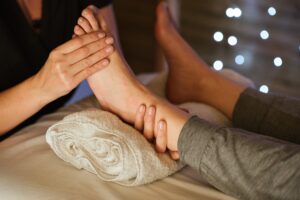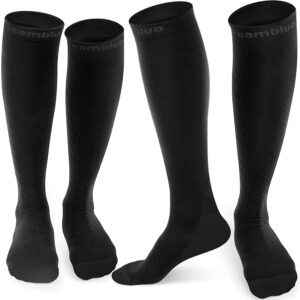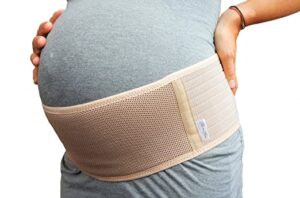Oedema or swelling is the collection of fluid in certain areas in the body. In pregnancy this is usually in the lower legs, ankles and feet and can often also be associated with cramp. Here is what the evidence says about the treatment options:
Symptoms:
-
Swelling can affect the hands, face, legs and feet but in pregnancy it is usually worse in the lower legs and ankles.
-
Swelling can sometimes cause the skin to appear more dry / flaky and discoloured.
-
Swelling is often uncomfortable due to the added pressure applied to the area affected.
-
Symptoms are often worse as the day progresses and ease after a nights sleep.
Causes:
-
The main cause of swelling in the body is water retention.
-
The growing uterus puts pressure on veins, arteries, blood vessels etc and this slows down blood flow to the legs, this, in turn, forces the fluid from the veins into the tissues of the legs, feet and ankles.
-
It is estimated that ladies have 50% more fluid in their body during pregnancy.
-
Another theory is that fluids are needed to ‘soften’ the body, which enables it to expand as the baby develops.
-
Higher temperatures can also affect the amount of swelling experienced by the mother.
-
If you are on your feet a lot of the day (especially if standing still) swelling tends to be worse in the legs.
-
Diets low in potassium or high in caffeine are also associated with increased swelling.
-
Carrying more than one baby can increase your chances of suffering from oedema.
-
Having an increased / excessive amount of amniotic fluid can increase your amount of swelling.
Aquatic Exercise – evidence is available to show the effectiveness of swimming / water exercises on leg oedema. THIS study showed that a single immersion exercise session is a safe, effective, and enjoyable complement, or alternative, to compression stockings for reduction of pregnancy related swelling.

Compression Stockings – The jury is still out as to whether compressions stockings can be helpful when it comes to swelling in pregnancy. THIS small study found that stockings did help with lower leg oedema in pregnancy, whereas THIS study found that compression stockings do not appear to have any advantages in reducing the leg oedema. All studies found have said that compression stockings like THESE, are safe to use in pregnancy but it is always advisable to speak to your GP before using them so you can be guided on timeframes and amount of compression needed.
Reflexology – Reflexology appears to help improve symptoms for women with leg oedema, but this is based on one small study.

Pregnancy support belts – There are very few studies that look into the use of maternity support belts when it comes to lower limb oedema. It is thought that by taking some of the weight out of the growing bump and supporting the back and pelvis it will allow for better blood flow and circulation thus resulting is a reduction in swelling (oedema).
There are currently no studies to show which support belts work best or for how long you should be wearing them, so we have put together our top 5 choices (here) to help guide you based on what they can help with and what we like about them.
Other remedies that are safe and easy to try but don’t have studies to back their use are:
- Avoid standing for long periods, try to stay active, especially exercises that ‘pumps’ the leg muscles (like Pilates / Yoga)
- Rest with your feet elevated if the swelling is in your legs / ankles / feet.
- Wearing trainers with good support can be more beneficial than harder or less supportive shoes.
- Drink water plenty of water.
- Avoid adding additional salt to meals.
Pilates – Pilates is low impact and can help strengthen / tone the muscles whist increasing circulation / blood flow. Have a look at our Top 5 online Pilates programmes here.
Yoga – Yoga is another safe, low impact exercise that helps to get the heart pumping and blood flowing. You can make your sessions as easy or hard as you like and push into twists and stretches as much is feels comfortable to you. There are lots of Online Yoga programmes available, have a look at our Top 5 here (and why we love them)! You can also read our blog on how yoga can help in other ways.

Symptoms to watch out for:
-
A sudden increase in swelling in your face, hands or feet.
-
A very bad headache.
-
Problems with your vision, such as blurring or flashing lights in your eyes.
-
Severe pain just below your ribs.
-
Vomiting with any of these symptoms.



